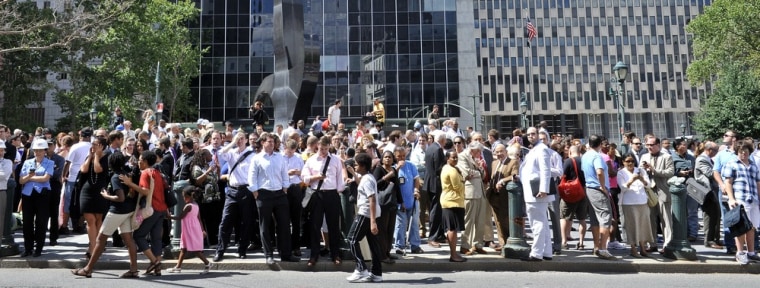A magnitude-5.8 earthquake in Virginia Tuesday afternoon was felt across the U.S. East Coast, shaking offices and nerves from Washington D.C. to New York City and as far south as Chapel Hill, North Carolina. There are even reports of shaking as far west as Columbus, Ohio, and out on Martha's Vineyard.
That's a whole lot of shaking for what amounts to a medium-sized quake. The reason for its reach, according to the U.S. Geological Survey, is geology of the East Coast.
"The reason an earthquake in the high 5s is felt so far away is that it occurred in an area … where the bedrock is solid, it's not really fractured or broken up by faults the way it would be, say, in California," Peter Powers, a geophysicist with the survey, told me today.
The seismic energy in areas with stable bedrock — "stable continental craton" in geophysics speak — can travel much farther than it can when broken up by young faults.
"Seismic energy attenuates very slowly on the East Coast," Powers said. "On the West Coast it attenuates much more rapidly because the bedrock is fractured and faulted and much more variable in its composition than on the East Coast."
The survey notes that earthquakes in the central and eastern U.S. are typically felt over a much broader region than those in the Western U.S., sometimes an area as much as ten time larger than similar magnitude earthquake on the West Coast.
"A magnitude 5.5 eastern U.S. earthquake usually can be felt as far as 300 miles from where it occurred, and sometimes causes damage as far away as 25 miles," the agency notes on its website.
Early reports indicated the depth of the earthquake is also quite shallow — just 3.7 miles down in the Earth's crust. Powers said this would likely be revised deeper as time goes by and the data is further analyzed, but depth here isn't much of a factor in the shaking.
The earthquake today on the East Coast, Powers said, was large enough to be felt over a large area no matter if its depth is ultimately determined to be 3 miles or 15 miles deep. "At that point, the depth really isn't much of a factor."
Depth can be a factor
In other regions, however, depth of an earthquake can make a difference.
Generally, the closer the epicenter of an earthquake is to the surface, the stronger the shaking on the surface and the more damage they cause, no matter what their size.
Conversely, when earthquakes rupture deeper in the crust — they can rupture up to 500 miles deep — more energy is lost as it races to the surface.
That's one reason why some relatively strong earthquakes, originating deep in the crust, cause little damage on the surface whereas some seemingly small earthquakes can cause massive damage.
The 7.0 magnitude earthquake in Haiti in January 2010 was 8.1 miles deep. The relatively shallow depth combined with subpar construction in Haiti caused massive damage there.
A pair of minor earthquakes in Spain this May ruptured just over half a mile below the ground, causing several deaths and damaging buildings in a part of the world with a tame seismic history.
The 9.0 magnitude earthquake hit Japan on March 11 began at a depth of 19.9 miles. Though devastating, it could have been worse had it been even shallower — and had Japan's infrastructure not been among some of the most earthquake ready in the world.
John Roach is a contributing writer for msnbc.com. Connect with the Cosmic Log community by hitting the "like" button on the Cosmic Log Facebook page or following msnbc.com's science editor, Alan Boyle, on Twitter (@b0yle).
